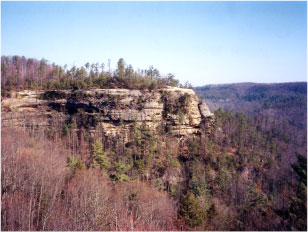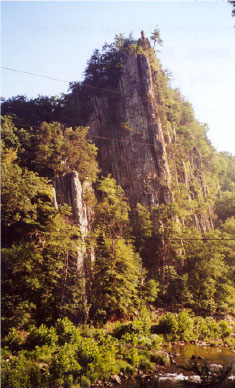
Appalachian Plateaus Physiography: Regional Setting (Part 2)
• The Plateaus province is characterized by deep narrow, disconnected valleys and steep, rugged mountain sides. Random, dendritic
The Plateaus and Valley and Ridge provinces have dramatically different landforms, as shown in the satellite photo, left. Differential weathering of tilted layers of different kinds of rock oriented northeast created the Valley and Ridge topography.
 In the Appalachian Plateaus, flat-lying beds offer the same resistance to erosion; therefore, a random (dendritic) pattern of erosion developed. The flat-lying beds of the Plateaus are shown (right) in Daniel Boone National Forest of Kentucky.
In the Appalachian Plateaus, flat-lying beds offer the same resistance to erosion; therefore, a random (dendritic) pattern of erosion developed. The flat-lying beds of the Plateaus are shown (right) in Daniel Boone National Forest of Kentucky.
 In the Valley and Ridge, tilted layers of rock weather differently. These tilted rocks (right), are in the Monongahela National Forest in West Virginia.
In the Valley and Ridge, tilted layers of rock weather differently. These tilted rocks (right), are in the Monongahela National Forest in West Virginia.
(Photographs by Phyllis Newbill)